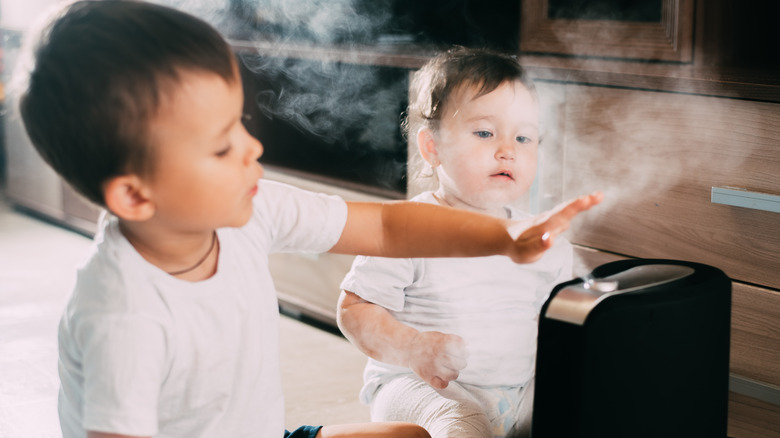Does Exposing A Child To Steam Or Cold Night Air Actually Help Treat Croup?
Usually occurring during the fall, winter, and early months of spring, croup is a respiratory condition that an estimated 6-8% of children will experience by the time they turn five years old, according to a 2008 scientific review published in Canadian Family Physician.
"Croup is a swelling of the voice box just below the vocal cords typically caused by a viral infection," Dr. Erin Kirkham, a pediatric otolaryngologist at University of Michigan Health C.S. Mott Children's Hospital, told Michigan Medicine's Health Lab. Most commonly, children with the infection will display a hoarse cough, which experts at Johns Hopkins Medicine liken to the barking of a seal. Additional symptoms may also include fever, voice loss, a runny or stuffy nose, and stridor. Stridor refers to a high-pitched wheezing sound that occurs when a child inhales.
Transmitted through direct contact, the virus progressively makes its way through the nose, throat, and lungs. Because children have smaller airways than adults, croup symptoms are more pronounced. In adults, a croup infection may not look all that different from a pesky cold.
Diagnosis and treatment methods for croup
When diagnosing croup, in addition to conducting a physical exam and analyzing a child's medical history, a physician may also issue a series of blood tests, chest and neck X-rays, or utilize a pulse oximeter to measure oxygen levels in the blood (via Johns Hopkins Medicine).
Treatment for croup can vary, depending on severity of illness, a child's age and health status, as well as what kind of croup infection it is. Although highly uncommon, some cases of croup can stem from bacterial infection, stomach reflux, or allergies. Additionally, treatment options may be different if a child is diagnosed with recurrent croup, in which a child incurs more than two croup infections during the course of a year (per Health Lab).
Generally speaking, however, if the child is more than 6 months in age, ibuprofen or Tylenol can be effective treatment methods for a fever of at least 100.4 degrees Fahrenheit, according to HealthyChildren.org. In addition, ensure the child stays hydrated by drinking plenty of liquids. Offering emotional support is also encouraged, such as rubbing the child's back, giving words of reassurance, or reading a favorite bedtime story to help keep them relaxed.
Is hot steam or cold air effective in treating croup?
When dealing with any kind of discomfort in the lungs or throat, sometimes a hot shower does just the trick both physically and emotionally — but is that also the case for croup? While inhaling hot steam may help ease labored breathing, there's no scientific evidence to suggest it's a viable treatment option for the condition (via HealthyChildren.org). On the other hand, however, is cold night air potentially more effective? Although experts at Johns Hopkins Medicine say there may be some benefits associated with exposing a child with croup to cool nighttime air, there is no research to prove that this is an effective cure either. Instead, try utilizing a cool mist humidifier to help with symptom relief.
In addition to sticking with the recommended treatment methods, consult with a pediatrician if a child displays signs of croup, particularly if their symptoms continue to linger even with at-home treatments. Should a child struggle to speak or catch their breath, have trouble swallowing saliva, develop blue lips or fingernails, or their stridor worsens, be sure to seek emergency medical care.



